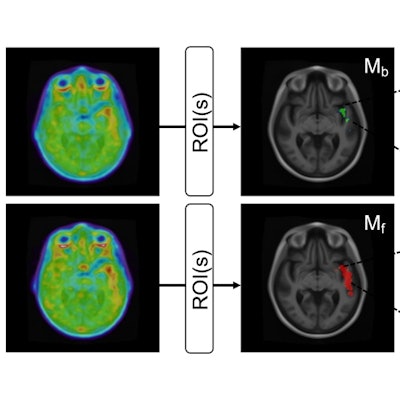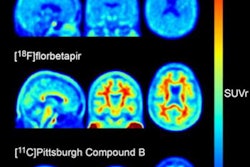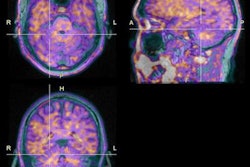
A new technique that tracks individual voxels on tau PET scans in patients with Alzheimer's disease appears effective for detecting early signs of the disease, according to a study published March 17 in the Journal of Nuclear Medicine.
A team at the Mayo Clinic in Rochester, MN, developed a method called the "overlap index" for tau PET imaging in which identical voxels showing tau protein deposits can be measured in serial scans over time. The approach may overcome some limitations in current tau PET imaging and could help identify patients early who are at risk of cognitive decline, according to the authors.
"By identifying voxels with consistent signal, the [overlap index] method could be helpful in measuring early tau PET signal," wrote first author Dr. Jeyeon Lee, a radiology research fellow, and colleagues.
Neurofibrillary tau tangles are widely thought to be responsible for the tissue damage that leads to cognitive decline in Alzheimer's disease patients. Tau PET imaging visualizes these tau tangles in regions of interest (ROIs) on brain tissue based on the signals radiotracers emit when they bind to tau protein, measuring them using standardized uptake value ratios (SUVRs).
Yet especially in early stages of tau development, longitudinal tau PET SUVR data is limited by variability between scans. Factors like the random decay of the radiotracer's isotope, attenuation, positron scatter, and even differences between scanner types get in the way of measuring slow, subtle changes, the authors wrote.
To overcome this "noise," the Mayo Clinic team developed the overlap index, an analytical method for identifying individual, identical voxels with stable tau protein signals. They hypothesized that the method could detect voxel-wise SUVRs sequentially in serial tau-PET scans.
The group identified 339 patients in the clinical Alzheimer's disease spectrum -- from those who were clinically unimpaired to those with dementia -- who underwent two or more serial tau PET scans in previous studies at the Mayo Clinic. They analyzed a total of 850 scans and evaluated associations between the overlap index and tau accumulations.
An analysis of scatter plots of 3D voxel intensity within specific ROIs demonstrated both low and high overlap index in patients, according to the findings.
 The overlap index was designed to identify voxels with stable high activity over time using two consecutive tau PET scans. Image courtesy of the Journal of Nuclear Medicine.
The overlap index was designed to identify voxels with stable high activity over time using two consecutive tau PET scans. Image courtesy of the Journal of Nuclear Medicine.In low-overlap index cases, the researchers observed inconsistent voxel signal increases over serial scans, even when the median SUVR of the overall region was above the abnormal tau-PET threshold (SUVR = 1.29). The median SUVR fluctuated above and below the threshold in these cases.
Conversely, high-overlap index cases revealed consistent high-intensity voxels over serial scans, with voxel clusters gradually enlarging based on visual assessments even when median SUVRs for the PET radiotracer did not increase. Notably, the median SUVRs in these cases was below the abnormal threshold.
Ultimately, SUVRs and overlap index showed significant linear correlations, with overlap index showing a better detection range in patients with low but higher than normal tau levels.
"Overlap index was more sensitive to tau signal elevation and longitudinal change than standard ROI measures, suggesting it is a more sensitive method for detecting early, subtle deposition of neurofibrillary tangles," the authors stated.
Initially, the overlap index method may be useful in distinguishing true tau accumulation from random variability in longitudinal studies, given that the method can characterize participants who will accumulate tau, the authors suggested.
However, further research is warranted, they wrote.
"Further optimization of [overlap index] methods to target the high meta-ROI group is an aim of our ongoing work," Lee and colleagues concluded.





















